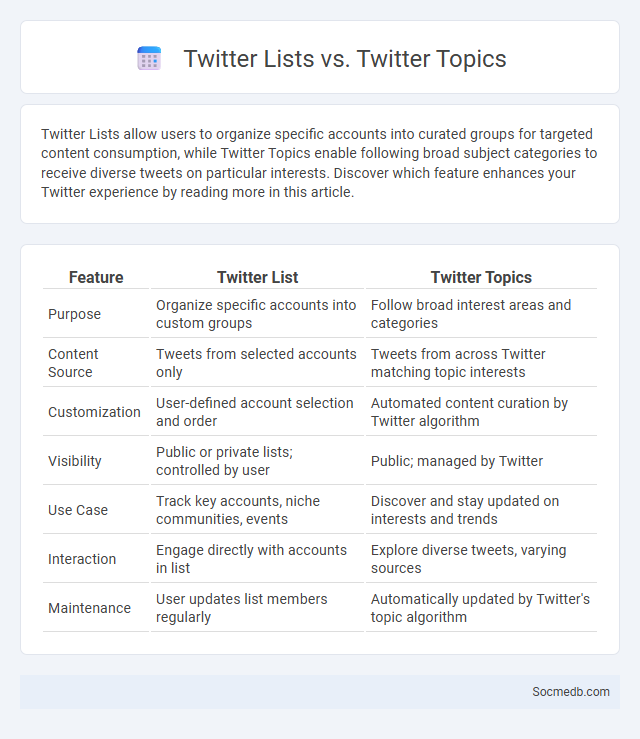
Photo illustration: Twitter List vs Twitter Topics
Twitter Lists allow users to organize specific accounts into curated groups for targeted content consumption, while Twitter Topics enable following broad subject categories to receive diverse tweets on particular interests. Discover which feature enhances your Twitter experience by reading more in this article.
Table of Comparison
| Feature | Twitter List | Twitter Topics |
|---|---|---|
| Purpose | Organize specific accounts into custom groups | Follow broad interest areas and categories |
| Content Source | Tweets from selected accounts only | Tweets from across Twitter matching topic interests |
| Customization | User-defined account selection and order | Automated content curation by Twitter algorithm |
| Visibility | Public or private lists; controlled by user | Public; managed by Twitter |
| Use Case | Track key accounts, niche communities, events | Discover and stay updated on interests and trends |
| Interaction | Engage directly with accounts in list | Explore diverse tweets, varying sources |
| Maintenance | User updates list members regularly | Automatically updated by Twitter's topic algorithm |
Introduction to Twitter Lists and Topics
Twitter Lists enable users to organize accounts into curated groups, enhancing content discovery and streamlining feed management. By categorizing followed profiles into specific themes or interests, users can efficiently monitor relevant conversations and engage with targeted communities. Similarly, Twitter Topics allow users to follow broader subjects, ensuring timely updates on trending discussions without needing to follow individual accounts.
What Are Twitter Lists?
Twitter Lists are curated groups of Twitter accounts organized by specific topics or interests, allowing users to filter content and follow updates from selected accounts without cluttering their main timeline. These lists can be public or private, providing a way to streamline information consumption and engage with focused communities. By using Twitter Lists, users enhance their social media experience through targeted content management and improved interaction with relevant tweets.
Understanding Twitter Topics
Twitter topics help users discover and engage with conversations relevant to their interests by categorizing tweets under specific themes. Understanding Twitter topics enables marketers and content creators to target audiences more effectively, improving message relevance and boosting engagement metrics. Analyzing trending topics through Twitter's API provides real-time insights into popular discussions, enhancing social listening and sentiment analysis strategies.
Key Differences: Lists vs. Topics
Lists on social media organize users or content into curated groups, enabling targeted engagement and personalized feeds, while Topics aggregate posts by subject matter, facilitating trend discovery and content exploration. Lists offer precise control over what appears in a user's timeline, often used to separate personal, professional, or interest-based connections. Topics enhance algorithmic content delivery by categorizing information around keywords and popular themes, aiding in real-time monitoring of conversations and emerging trends.
Creating and Managing Twitter Lists
Creating and managing Twitter Lists allows users to organize accounts into focused groups, enhancing content curation and engagement. Lists can be made public for wider accessibility or private for personal use, enabling effective monitoring of industry trends, competitors, or influencers. Regularly updating these lists ensures relevance and maximizes the efficiency of content discovery on the platform.
How to Follow and Unfollow Twitter Topics
To follow Twitter topics, you can tap the "Explore" tab, select "Topics," then choose subjects that interest you to see relevant tweets in your timeline. To unfollow a topic, go back to the "Topics" section, find the topic you want to remove, and tap "Following" to unfollow it. Managing your Twitter topics helps tailor your feed to show content that matches your interests, enhancing your social media experience.
Pros and Cons of Using Twitter Lists
Twitter Lists offer users an efficient way to organize and filter content by grouping accounts based on interests, enhancing content discovery and reducing information overload. However, these lists can create echo chambers by limiting exposure to diverse viewpoints and require regular management to stay relevant. Users benefit from improved curation but must balance between focused feeds and maintaining a broad social media experience.
Pros and Cons of Following Twitter Topics
Following Twitter topics enables users to receive curated content tailored to their interests, enhancing engagement and staying updated on relevant news and trends. However, reliance on selected topics can lead to echo chambers, reducing exposure to diverse perspectives and increasing the risk of misinformation. Balancing topic subscriptions with varied sources promotes a well-rounded social media experience on Twitter.
Best Practices for Organizing Your Twitter Feed
Organizing your Twitter feed effectively involves curating lists based on topics, industries, or interests to streamline content discovery and minimize noise. Prioritize following authoritative accounts and regularly update your lists to maintain relevance and engagement. By tailoring your feed to align with your goals, you enhance your Twitter experience and ensure you receive valuable information seamlessly.
Which Is Better: Twitter Lists or Twitter Topics?
Twitter Lists offer curated control by allowing users to group specific accounts for targeted content, enhancing personalized engagement and efficient information filtering. Twitter Topics provide broader content discovery by aggregating tweets around general themes, helping users explore trending conversations without manually selecting sources. Choosing between Lists and Topics depends on whether users prefer precise customization with Lists or dynamic exploration with Topics for their social media strategy.
 socmedb.com
socmedb.com